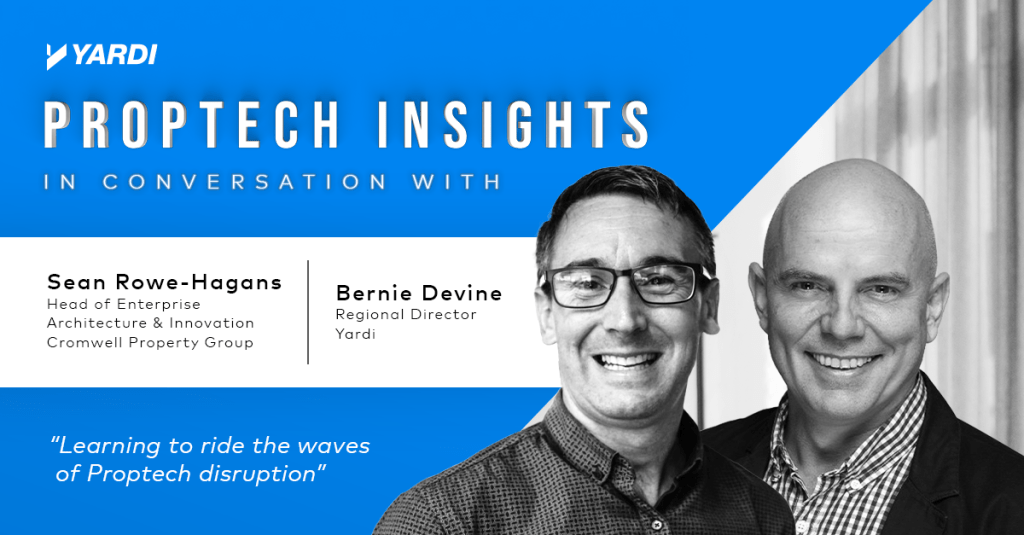What’s the best way for a real estate company to flex its innovation muscle? Robust evaluation. That’s the key takeaway straight from two property technology specialists, Cromwell Property Group’s Sean Rowe-Hagans and Yardi’s Bernie Devine. Devine, regional director for Yardi in APAC, caught up with Rowe-Hagans in the latest installment of Yardi Proptech Insights. The series dives deep to get beneath the surface of property technology. Unzipping efficiencies As Head of Enterprise Architecture and Innovation, Rowe-Hagans has been driving Cromwell’s culture of problem solving through technology for more than a decade. Established in 1998, Cromwell has grown from a small Australian property syndicate to a real estate investment trust with 3.4 million square metres across three continents. Cromwell has a razor-sharp focus on operational efficiencies, and technology and data play a big part in unzipping those efficiencies, Rowe-Hagans noted. But Cromwell adopts technology sensibly and strategically – and the secret is to start with business strategy. “You have to identify a gap before you go looking to fill it with technology,” Rowe-Hagans observed. Cromwell doesn’t currently have too many gaps to fill. “But that doesn’t mean we can’t do things better,” Rowe-Hagans added. Technology should be evaluated “almost as if you are a venture capital firm”. Do your due diligence or risk a big “technology debt,” Rowe-Hagans advised. “You don’t want to be driving down that road, especially if your strategy is efficiency.” Cromwell’s short-term strategic focus may be on efficiency, but its long-term lens is pointed on “business resilience” – and that means thinking “not just about how our buildings run but about how our business runs.” Unpacking the business case Building a business case before a big technology implementation is often the easiest step, Devine observed. That is, until two years later, when it’s time to assess the benefits of a technology investment and “no one knows what it has delivered.” Rowe-Hagans, who spent many years in IT project management, agreed. “The bit after the implementation is the tough bit.” That’s when resources and focus fall away. “Without careful management or monitoring, within two years of that implementation the system will be costing you more than you even began to imagine when you were running that evaluation.” Cromwell assesses “not just reactive risk but also future risk,” Rowe-Hagans said. This means more than going with a gut feeling and a lot of time investigating global megatrends and materiality matrices. “We are really interested in that long-term vision – not just plugging a hole for the now.” Technology implementations are also evaluated against the user experience and how it will be maintained throughout its lifecycle. “Smart” organisations appoint “process champions,” Devine said. Others often “neglect” technology after its implementation. “But it’s like a marriage. If you don’t invest in the marriage, it falls apart.” The real estate industry’s challenge is to be both reactive and agile – and that means each player must think big picture. “It’s about the ecosystems we are trying to build in this technology world – and that’s not just about Cromwell. It’s about all of us as an industry.” Building the ecosystem Rowe-Hagans gave a tip of the hat to Yardi for its role helping to build the ecosystems that each sector of the property industry needs to thrive. Yardi’s work capturing the lifecycle of a building – from leads to when a tenant leaves – was case in point, Rowe-Hagans noted. The real estate industry is starting to come together to collaborate and connect around data governance and sharing. “But it’s not there yet,” he added. The challenge ahead, nevertheless, looms large. By 2025, according to Yardi’s most recent whitepaper, the world will be generating an astronomical 175 zettabytes of data. This is “too many zeroes,” said Devine. If each bit was a coin, one zettabyte of coins in a stack would reach to the nearest star system, Alpha Centauri, 600 times....

